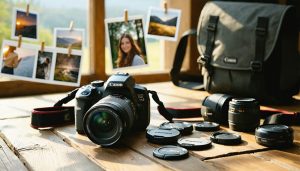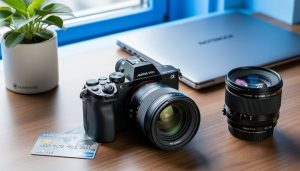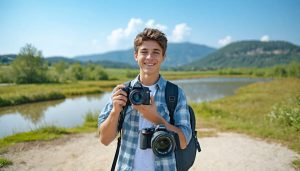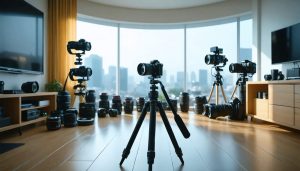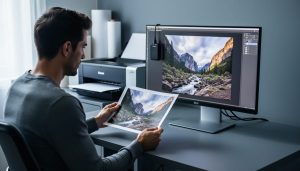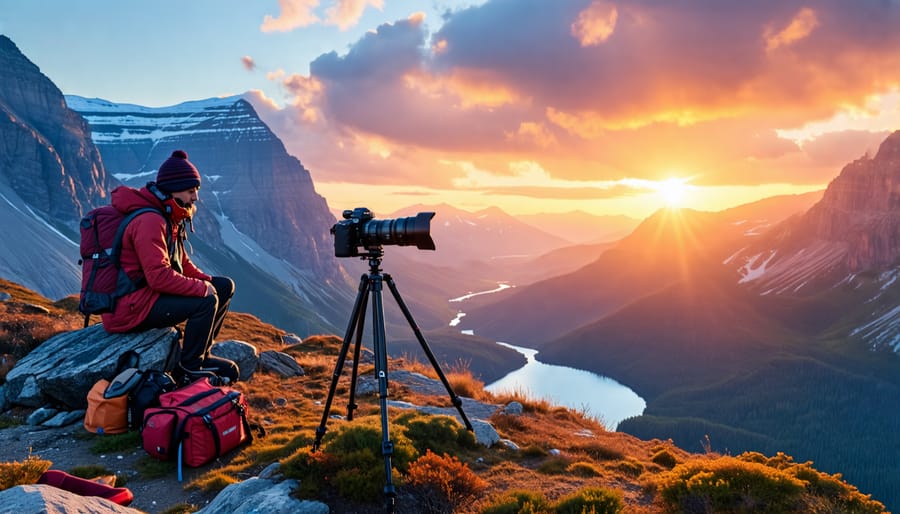
Invest in a sturdy, lightweight tripod to ensure sharp images in low light and with slower shutter speeds. Choose a camera body with high resolution, good dynamic range, and weather sealing for durability in the elements. Select lenses that cover wide-angle to telephoto focal lengths, with fast apertures for low light and creative control over depth of field. Pack essential accessories like neutral density and polarizing filters, extra batteries and memory cards, a remote shutter release, and a headlamp for setting up in the dark.
Camera Body
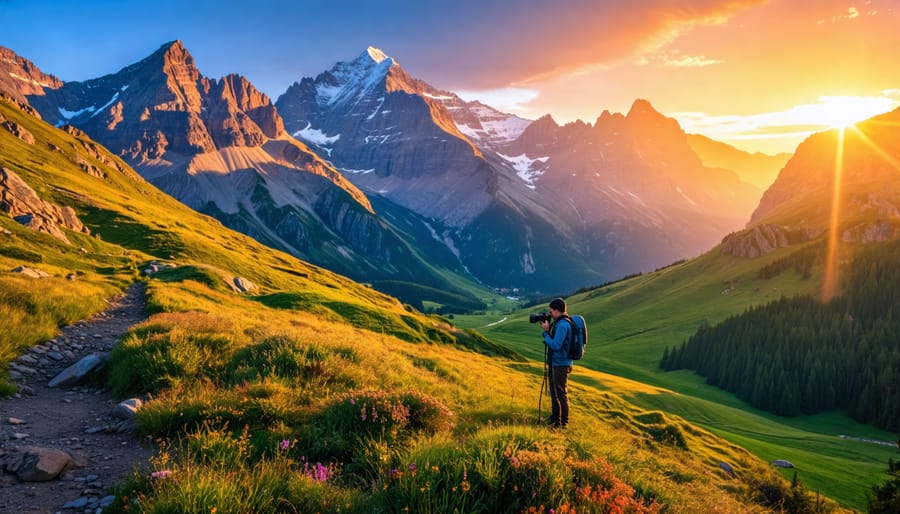
DSLR vs. Mirrorless
When it comes to choosing a camera for landscape photography, the debate often comes down to DSLR vs mirrorless. Both have their strengths and weaknesses. DSLRs have been the go-to choice for many years, offering excellent image quality, wide lens selections, and rugged builds. However, mirrorless camera options have rapidly caught up and even surpassed DSLRs in some areas. Mirrorless cameras are typically lighter and more compact, making them ideal for hiking and travel. They also offer superior autofocus, especially for video. However, DSLRs still have an edge in battery life and often a more comprehensive native lens selection. Ultimately, both can deliver outstanding landscape images. It comes down to personal preference and specific needs – portability, video features, lens options, and budget. Renting or borrowing both types can help you decide which system fits you best.
Recommended Camera Bodies
When selecting a camera body for landscape photography, consider full-frame models for their superior low-light performance and dynamic range. The Sony A7R IV offers high resolution and excellent autofocus, while the Canon EOS R5 boasts fast shooting speeds and 8K video capabilities. For those on a budget, the Nikon D780 delivers great image quality in a robust DSLR body.
Mirrorless options like the Fujifilm X-T4 provide a compact form factor without compromising on features. Its weather-sealed body and in-body image stabilization make it a strong contender for outdoor shoots. If you prefer a DSLR, the Canon EOS 6D Mark II offers a full-frame sensor at an affordable price point, making it an excellent entry-level choice for landscape enthusiasts.
Ultimately, the best camera for you will depend on your specific needs, preferences, and budget. Look for models with good low-light capabilities, wide dynamic range, and weather sealing for optimal landscape photography performance.
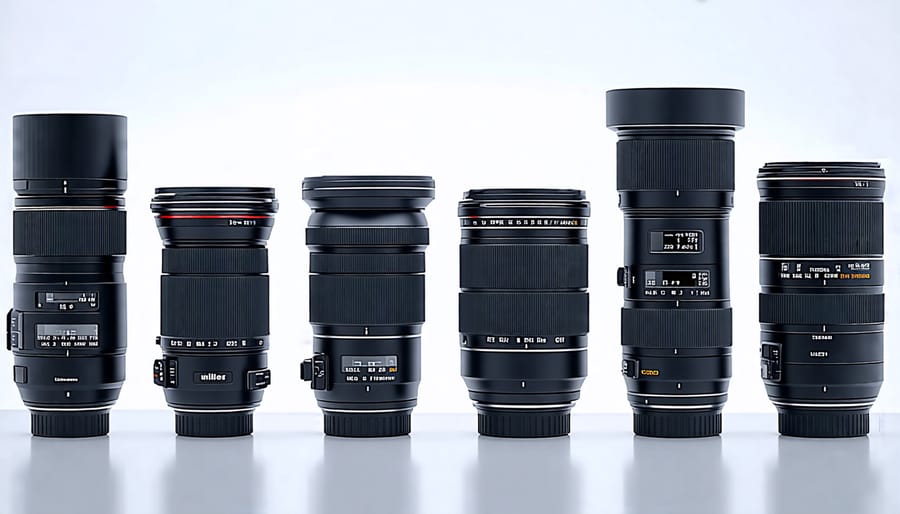
Lenses
Wide-Angle Lenses
Wide-angle lenses are essential for capturing the grandeur and expansive beauty of landscapes. With focal lengths typically ranging from 10mm to 35mm, these lenses allow you to fit more of the scene into your frame, creating a sense of immersion and depth. Wide-angle lenses are particularly useful for emphasizing foreground elements, such as interesting rocks, plants, or patterns in the terrain, while still showcasing the distant horizon or sky. When shooting with a wide-angle lens, you can get close to your foreground subject to make it appear larger and more prominent, adding visual interest and leading the viewer’s eye into the scene. Some popular focal lengths for landscape photography include 14mm, 16mm, 24mm, and 35mm, with the wider options being ideal for vast, sweeping vistas and the slightly longer lengths providing a more natural perspective. Experiment with different wide-angle focal lengths to find the one that best suits your creative vision and style.
Telephoto Lenses
Telephoto lenses, typically with focal lengths over 70mm, can be powerful tools for landscape photography. While wide-angle lenses are often the go-to choice, telephotos allow you to compress perspective and create stunning, layered compositions. By zooming in on distant subjects, you can eliminate distracting foreground elements and emphasize patterns, textures, and shapes that might be lost in a wider view.
Telephoto lenses are also excellent for isolating and highlighting specific features in the landscape, such as a lone tree, a mountain peak, or a distant waterfall. The compressed perspective can make background elements appear closer to the subject, adding depth and dimensionality to the image.
When using a telephoto lens for landscapes, a sturdy tripod is essential to minimize camera shake and ensure sharp images. Experiment with different focal lengths and compositions to create unique and compelling images that showcase the beauty of the landscape in a new way.
Lens Filters
Lens filters are essential tools for landscape photographers looking to elevate their images. A circular polarizer is a must-have, as it reduces glare, enhances color saturation, and adds contrast to skies and foliage. Neutral density (ND) filters are another crucial accessory, allowing you to use slower shutter speeds in bright conditions for creative effects like silky water or blurred motion. Graduated ND filters help balance exposure between bright skies and darker foregrounds. When selecting filters, consider quality optical glass for sharpness and color accuracy. Refer to our lens recommendations for top-performing filter-friendly lenses. With the right filters in your kit, you’ll have the tools to capture stunning, creative landscape images.
Tripod
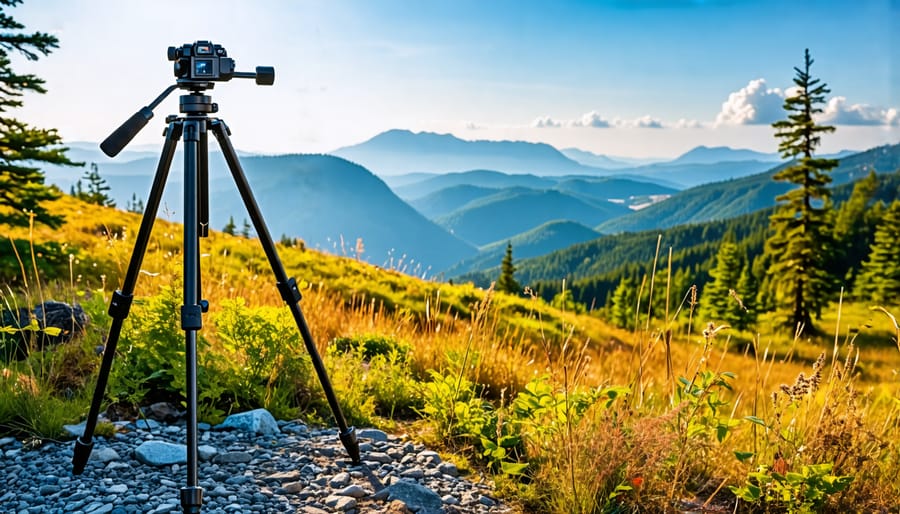
Tripod Features to Consider
When choosing a tripod for landscape photography, consider the material it’s made from. Carbon fiber tripods are lightweight yet sturdy, making them ideal for hiking and travel. Aluminum tripods are heavier but often more affordable. Weight is another key factor – look for a tripod that balances stability and portability based on your needs.
Maximum load capacity indicates how much weight the tripod can support. Ensure it can comfortably hold your camera and heaviest lens combination with a safety buffer. Height is also crucial; the tripod should extend tall enough for comfortable eye-level shooting without requiring significant crouching.
Additional features to look for include a versatile ball head for smooth operation and easy adjustments, leg locks that are secure and quick to operate, and interchangeable feet (like spikes for soft terrain and rubber pads for rock). By carefully evaluating these features, you can find a quality tripod that will provide a stable foundation for your landscape photography adventures.
Recommended Tripods
Here are some highly recommended tripods for landscape photography:
The Manfrotto MT055CXPRO3 Carbon Fiber Tripod offers excellent stability and durability at a mid-range price point. Its lightweight carbon fiber construction makes it ideal for hiking to remote locations.
For those on a tighter budget, the Vanguard Alta Pro 2+ 263AB 100 Aluminum Tripod delivers great performance at an affordable price. Its versatile center column allows for low-angle shooting.
If portability is a top priority, consider the travel-friendly Gitzo GT1545T Series 1 Traveler Carbon Fiber Tripod. This compact option folds down small without sacrificing stability.
At the high end, the Really Right Stuff TVC-24L Mk2 Carbon Fiber Tripod is a top choice of many pros for its uncompromising build quality, stability, and smooth operation. While pricey, it’s a worthwhile investment for serious landscape photographers.
Remote Shutter Release
A remote shutter release is a valuable accessory for landscape photographers looking to capture sharp images and create long exposure effects. By allowing you to trigger the shutter without physically touching the camera, a remote release helps to minimize camera shake caused by pressing the shutter button. This is especially important when using slower shutter speeds or shooting in low light conditions where even the slightest movement can result in blurry photos.
Remote shutter releases come in various forms, including wired and wireless options. Wired releases connect directly to your camera, while wireless models use infrared or radio signals to communicate with the camera. Both types enable you to trigger the shutter from a distance, giving you more flexibility in your shooting position and reducing the risk of disturbing your carefully composed shot.
In addition to minimizing camera shake, remote shutter releases are essential for creating long exposure photographs. When using shutter speeds longer than 30 seconds, most cameras require you to use a remote release to keep the shutter open for the desired duration. This is particularly useful for capturing stunning images of moving water, star trails, or light trails in low light environments.
When choosing a remote shutter release, ensure that it is compatible with your specific camera model. Some high-end releases offer additional features like built-in timers, interval shooting for time-lapses, and the ability to program custom exposure sequences. Whether you opt for a simple wired release or a feature-packed wireless model, a remote shutter release is a must-have accessory for any serious landscape photographer.
Camera Bag
A reliable, comfortable camera bag is an essential piece of gear for any landscape photographer. When venturing out into nature to capture stunning vistas, you need a bag that can protect your valuable equipment from the elements and potential hazards. Look for a bag with padded compartments to safely store your camera body, lenses, filters, and other accessories. Consider the bag’s size and capacity based on the amount of gear you typically carry. A backpack-style bag is often preferable for landscape photography, as it distributes weight evenly and keeps your hands free during hikes or treks to remote locations. Weather-resistant materials like nylon or canvas offer added protection against rain, dust, and moisture. Customizable dividers allow you to organize your gear efficiently, ensuring quick access when you need to switch lenses or grab a filter. Additional features like external tripod straps, laptop compartments, and easy-access pockets for small items can enhance the functionality of your camera bag. Ultimately, investing in a high-quality, durable camera bag provides peace of mind, knowing your equipment is secure as you focus on capturing the perfect landscape shot.
Conclusion
In conclusion, having the right landscape photography equipment is essential for capturing stunning images that do justice to the beauty of nature. From a reliable camera body and high-quality lenses to a sturdy tripod and filters, each piece of gear plays a crucial role in achieving the desired results. While it’s easy to get caught up in the latest and greatest technology, remember that the most important tool is your creative vision and technical skill.
As you build your landscape photography kit, invest in quality equipment that will withstand the rigors of outdoor shooting and deliver excellent image quality. With the right tools in your hands and a passion for exploring the world through your lens, you’ll be well on your way to creating breathtaking landscape photographs that showcase the magnificence of our planet.

